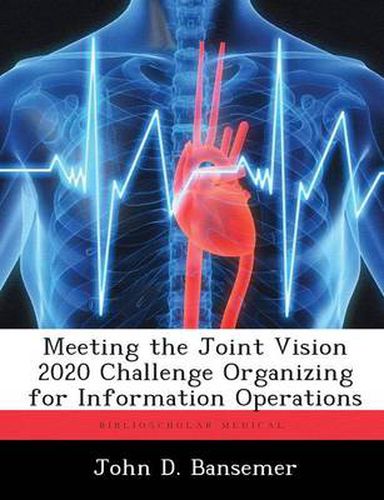Readings Newsletter
Become a Readings Member to make your shopping experience even easier.
Sign in or sign up for free!
You’re not far away from qualifying for FREE standard shipping within Australia
You’ve qualified for FREE standard shipping within Australia
The cart is loading…






This title is printed to order. This book may have been self-published. If so, we cannot guarantee the quality of the content. In the main most books will have gone through the editing process however some may not. We therefore suggest that you be aware of this before ordering this book. If in doubt check either the author or publisher’s details as we are unable to accept any returns unless they are faulty. Please contact us if you have any questions.
Joint Vision 2020 recognizes the increasing importance of operations within the information domain as well as the need to have appropriately designed organizations prepared to support and conduct operations within the information domain. This paper provides an initial framework to assess organizational structures for IO using the evolution of British and American airpower organizations during the interwar years. This analysis will show how, over time, the debate over organizing air forces became centered on a core set of criteria. Applying these criteria to IO will provide a preliminary determination of the degree of organizational autonomy warranted for IO. In a similar manner, the organizational decisions made during the interwar years had direct implications on both airpower and service organizations. These implications will be assessed against three organizational constructs: an independent IO service, semi-autonomous service organizations, and a joint unified command. This analysis will illustrate that an independent service is not warranted at this time; however, it does point to a requirement to grant greater autonomy to IO organizations within the services to help foster operational and doctrinal innovation. Finally, a pre-existing joint unified command should assume control of all IO capabilities to ensure the proper integration of the many disparate capabilities grouped under the IO rubric.
$9.00 standard shipping within Australia
FREE standard shipping within Australia for orders over $100.00
Express & International shipping calculated at checkout
This title is printed to order. This book may have been self-published. If so, we cannot guarantee the quality of the content. In the main most books will have gone through the editing process however some may not. We therefore suggest that you be aware of this before ordering this book. If in doubt check either the author or publisher’s details as we are unable to accept any returns unless they are faulty. Please contact us if you have any questions.
Joint Vision 2020 recognizes the increasing importance of operations within the information domain as well as the need to have appropriately designed organizations prepared to support and conduct operations within the information domain. This paper provides an initial framework to assess organizational structures for IO using the evolution of British and American airpower organizations during the interwar years. This analysis will show how, over time, the debate over organizing air forces became centered on a core set of criteria. Applying these criteria to IO will provide a preliminary determination of the degree of organizational autonomy warranted for IO. In a similar manner, the organizational decisions made during the interwar years had direct implications on both airpower and service organizations. These implications will be assessed against three organizational constructs: an independent IO service, semi-autonomous service organizations, and a joint unified command. This analysis will illustrate that an independent service is not warranted at this time; however, it does point to a requirement to grant greater autonomy to IO organizations within the services to help foster operational and doctrinal innovation. Finally, a pre-existing joint unified command should assume control of all IO capabilities to ensure the proper integration of the many disparate capabilities grouped under the IO rubric.